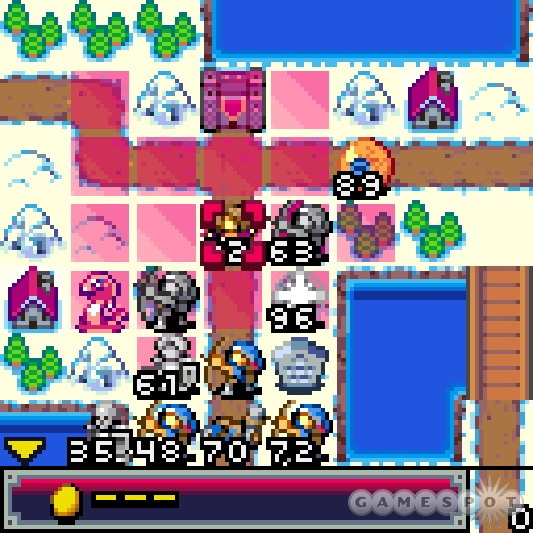The original Ancient Empires was a landmark mobile game that delivered a more than respectable take on the turn-based strategy genre. Clearly owing a considerable debt to Advance Wars, gameplay centered around a series of tight, tense missions in claustrophobic arenas, with an interesting array of units and a dash of resource management. Now, the eagerly anticipated sequel brings more of the same, but with overhauled visuals and, most importantly, genuinely challenging artificial intelligence.

The plot kicks off soon after the climax of the original story. King Galamar has defeated his treacherous brother Valadorn, who, it turns out, had been possessed by a shadow demon named Saeth. Now the two must join forces to ensure Saeth doesn't get his nasty hands on a collection of magical gems that would let him control the kingdom of Thorin. You have eight combat missions in which to thwart his plans. There are straightforward face-offs; there are chase scenes; and there are ambushes. The whole gamut of the turn-based strategy genre is presented...on your mobile.
Veterans will immediately notice the refreshed roster of units, taking in familiar staples and some like-for-like swaps. Soldiers and archers are back, fulfilling their roles as the basic pawns in your plans. Then there are the obvious substitutes: The magicians of AE have become sorceresses that, once again, have powers to reanimate the dead; the usefully amphibious lizard men are now water elementals; and the poisonous spiders have been swapped for dire wolves. Each of these have slightly tweaked stats, but their roles within the game are almost identical.
This is really the only disappointment of the game. Apart from soldiers being able to repair damaged buildings, most of the unit types are the same as they were in the previous game. So veterans may find themselves falling back on familiar tactics. It would have been great to see a few newcomers with, say, longer-range attacks or different magical abilities--or even transport units, like ships or carts, that would let players deploy groups of units across greater distances. Things are bought back on track with the subtly improved and crisply detailed environments. The camera has been pulled back, giving you a better overview of the war zone, and the depiction of hills, trees and water is more refined, edging away from the cloying cuteness of the original toward a simplified realism. There are nice little details, too, like sparkles on the surface of lakes, dust behind moving units, and anime-esque magic effects. In the background, there's a range of suitably atmospheric tunes, ranging from slow moody orchestral-style pieces at the beginning of each mission to exciting, pacy compositions that accompany enemy turns. In terms of the audiovisual experience, slowly but surely, we're edging toward Game Boy Advance territory.
The interface is now easier to use. In AE, each unit's movement and attack distances were shown only by an outline that tended to get a little lost in the background. However, in AE II, all the effective squares are highlighted, providing you with a much clearer impression of your options. Also, your units are now shaded gray when they've ended their turns, again providing instantaneous feedback. On top of all that, units now gain a new rank every time they engage in combat. So now it's really clear who your veterans are (the original AE simply upped their stats without informing you, so it was difficult to both keep up with and exploit the changes). These seem like small elements, but on a crowded battlefield with a dozen units to command, strong visual indicators really help you out.
Battle is varied and a heck of a lot more challenging. Part of this is due to the greater range of units, which pack loads of interconnected advantages and disadvantages. You'll want to send your catapult in to break down enemy buildings, but soldiers need to follow quickly to rebuild and occupy. Meanwhile, archers have to get involved for long-range support, perhaps with a sorceress lurking nearby to mop up the corpses. All told, it's a bountiful pick-and-mix candy store for tactics fans.
Add in the need to counteract similar strengths and weaknesses in enemy units, and the logistics become incredibly complex. But they also become utterly compelling. Each move must be pored over for several minutes, with the implications spreading out across the landscape like wildfire.
But it's the improved AI that really impresses. In the original game, enemy troops wander around aimlessly, seemingly unaware of one another...or you, for that matter. Now they attack in groups, identifying your most valuable units or ganging up on weakened troops. There's a greater battle over resources, too. Typically for this genre, the more buildings your soldiers inhabit, the more gold is generated, which means the more new units you can purchase. In AE, it was pretty easy to gain control of this resource element, but now the enemy quickly sends out its soldiers with occupation very much in mind, protecting these pillagers with more-powerful units. Enemies also seem to react to your tactics by cutting off any scout parties you may send out to take their fortresses and by surrounding any units you group too closely together. Diversity is the key to survival, which we discovered after reaching mission four, where we soundly got beaten nine times in a row.
As you plow slowly though the eight main missions, you also open up a range of challenging skirmishes, such as self-contained four-player battle scenarios with participants teaming up in groups of two per side (if there are only two of you, you can team up against the computer). It's a generous addition that adds hours of extra battle action to an already considerable package. Ancient Empires II, then, is a genuine must-have. It's deep, engrossing, good-looking, and long-lasting. It may well be the most sophisticated strategy game currently available on this platform. And, perhaps best of all, it ends with a cliff-hanger. This empire, we hope, has many more battles to offer.
